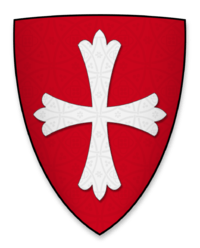Eustace de Vesci
Eustace de Vesci (1169–1216) was an English lord of Alnwick Castle, and a Magna Carta surety.[1] He also held lands in Sprouston, Roxburghshire, Scotland as brother in-law to King Alexander II of Scotland. Eustace was a leader during the Barons' War in 1215 and was killed while undertaking a siege of Barnard Castle in 1216.
Eustace de Vesci | |
|---|---|
| Lord of Alnwick | |
 Arms of Eustace de Vescy, Lord of Alnwick Castle.Gules, a cross flory/patonce argent | |
| Died | 1216 Barnard Castle, County Durnham |
| Buried | Alnwick Abbey |
| Noble family | de Vesci |
| Spouse(s) | Margaret of Scotland |
Issue
| |
| Father | William de Vesci |
| Mother | Burga de Stuteville |
Early life
His parents were William de Vesci and Burga de Stuteville, daughter of Robert III de Stuteville. He paid his relief on coming of age in 1190.[2] He was with King Richard I of England in Palestine in 1191.[3] On 13 August 1199 he appeared as one of the guarantors of the treaty between the new king John of England and Renaud I, Count of Dammartin, and in the same year, probably later, he was sent to William the Lion of Scotland to promise him satisfaction of his rights in England, and witnessed his homage on 22 November 1200.
He witnessed charters frequently in the early years of John's reign, in 1209 was one of the guardians of the bishopric of Durham, and on 10 April of the same year he was sent to meet William The Lion on his visit to England. He was serving the king in Ireland from June to August 1210. Accused of conspiring against John in 1212, he fled to Scotland. A tale of John's attempted seduction of his wife, and the trick played on him, first appears in Walter of Hemingburgh and bears a close resemblance to a classical model.
His lands were seized, but after John's submission to the pope he was forced to invite Vescy back (27 May 1213), though orders were sent on the same day to Philip of Oldcoates to cripple him by destroying his castle of Alnwick. On 18 July 1213 he was one of the recipients of John's pledge to abide by the decision of the pope concerning the things about which he had been excommunicated. On 5 November 1214 Pope Innocent III warned him not to trouble the king.
The Barons' Revolt
He was a leader in the First Barons' War, in 1215 marching south against King John I with Robert Fitzwalter.[4] He was prominent among the barons who wrung Magna Carta from John, and was one of the twenty-five appointed to see it carried out.[5] He was excommunicated by name with others of the barons in 1216. He supported in the confused situation ensuing Louis, the French dauphin, who was claiming the English throne.[6] He was killed at a siege of Barnard Castle; while he accompanied Alexander II of Scotland on his way to do homage to Louis of France, on the way they laid siege to Barnard Castle, belonging to Hugh de Balliol, and, approaching too near, Vescy was shot through the head by an arrow.
His lands were confiscated and given to Simon de Champ Rémy, Philip de Ulecot, and William de Harcourt.
Family
He married Margaret, half-sister of King Alexander II of Scotland,[7] an illegitimate daughter of William the Lion by a daughter of Adam de Hythus.[8] They had:
- William de Vesci, who was father of John de Vesci and of William de Vescy. The latter was one of the Competitors for the Crown of Scotland in 1291.[9][10]
- Christiana, married Patrick de Riddell, had issue.
Notes
- Richardson, Douglas, Magna Carta Ancestry, Baltimore, Md., 2005, p.xi, ISBN 0-8063-1759-0
- Browning, Charles H. (2002) [1915]. Magna Charta Barons and Their Descendants: With the Story of the Great Charter of King John: Sketches of the Celebrated Twenry-Five Sureties for Its Observance, and Their Lineal Decents. Baltimore: Genealogical Publishing Company. p. 129.
- "The Baronage". The Baronial Order of Magna Charta & The Military Order of The Crusades. Magnacharta.com. Archived from the original on 13 September 2012. Retrieved 17 October 2012.
- Sommerville, J.P. "The Crisis of John's Reign". University of Wisconsin–Madison. Retrieved 17 October 2012.;Smith, Andrew P. "Northumbria". Durenmar: Arx Peritae. Durenmar.de. Archived from the original on 28 November 2012. Retrieved 17 October 2012.
- "Magna Charta Barons". The Baronial Order of Magna Charta & The Military Order of The Crusades. Magnacharta.com. 1998. Retrieved 17 October 2012.
- Jim Bradbury, Philip Augustus (1998), p.318.
- thePeerage.com - Person Page 10780
- Dunbar, Sir Archibald H., Bt., Scottish Kings, Edinburgh, 1899, p.84
- Rymer, Thomas Foedera, London, 1704, vol.1, part 2, p.776
- Dunbar, Sir Alexander (1899) p.282-3: Pedigree Showing the Thirteen Competitors for the Scottish Crown &c.
References

External links
- Baronial Order of Magna Charta
- Enforcers of Magna Carta via Oxford DNB